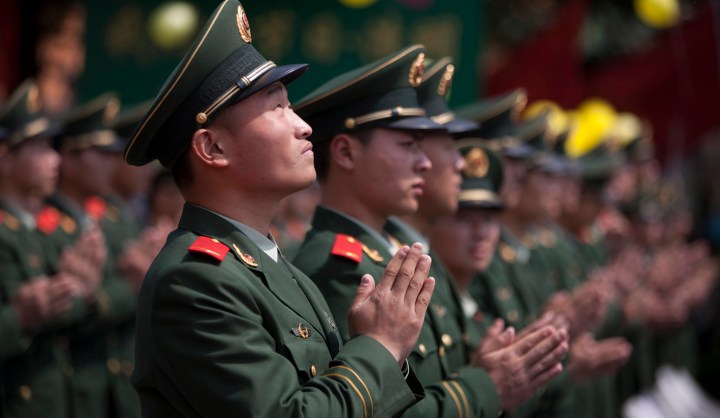Newsdeck
Chinese public wary of fudged numbers

Data releases on corruption and home ownership are arousing huge controversy in China for being wildly out of step with reality. An anti-graft survey showing more than 70% of the people happy with state efforts to tackle the scourge is being widely derided as faked, while the destitute in particular are outraged by figures pointing to the average urban family owning more than one home. By Wu Zhong
Official claims that more than 70% of Chinese people now feel satisfied with the effectiveness of Beijing’s crackdown on corruption and over 80% agree that official corruption has been effectively checked. These figures don’t tally, however, with the generally perceived reality that the majority of Chinese people are still outraged with official corruption run amok. Therefore, they are under intense scrutiny.
The second set of figures show that private ownership of housing in China has reached nearly 90%, far above the world average of 60%. And every urban family now own 1.22 flats. Needless to say, this has caused an uproar, especially among the homeless. Even property developers are not happy with such numbers as they suggest a saturated housing market.
The anti-graft statistics were released by Cui Hairong, deputy director of the National Bureau of Corruption Prevention at an international conference hosted by Hong Kong’s Independent Commission Against Corruption. Cui said China had received praise at home and abroad for its stepped-up efforts to crack down on corruption in recent years. From 1982 to 2011 more than 4.2-million Communist Party and government officials – of whom 465 were at minister-level or higher – were punished for violating party discipline or state laws.
More than 90 high-ranking officials had been convicted of corruption and dealt with by the law. Most notable were the executions. Cheng Kejie, the former vice chairman of the National People’s Congress, Hu Changqing, the former vice governor of Jiangxi province, former vice governor of Anhui province Wang Huizhong and the former director of state drug administration Zheng Xiaoyu were put to death between 2000 and 2007 for taking huge bribes. Over 42,000 officials were prosecuted for corruption from 2003 to 2011.
These figures could be interpreted in a number of different ways. From the pessimistic perspective, they show official corruption runs increasingly rampant as the number of officials convicted of corruption tends to grow and the evil trend spreads higher up the ranks. Two politburo members, former Beijing and Shanghai party secretaries Chen Xitong and Chen Liangyu, have been jailed for corruption. Former Chongqing party secretary Bo Xilai may soon become the third. Optimists might say all this is evidence of Beijing’s efforts.
Taking the optimistic line, Cui cited statistics to conclude Chinese people had become increasingly happy with Beijing’s campaign against corruption. According to him, by the end of 2011, 72.7% of Chinese people felt satisfied with the effectiveness of the anti-graft drive, up from 51.9% in 2003, and 83.8% of people agreed that official corruption had been curbed to some extent, up from 68.1% in 2003.
His speech, however, caused a public uproar after being widely reported in the state-run media. Comments in the media and on websites questioned whether and how such figures could be fabricated. The numbers failed to tally with the generally perceived reality. Official corruption has remained one of the top concerns in opinion polls over recent years.
In China, nine out of 10 people, including officials, would shake their heads if asked about whether corruption has been effectively checked. In speeches over the past couple of years, President Hu Jintao and Premier Wen Jiabao have repeatedly highlighted corruption as a problem concerning the “life or death” of the Communist Party and the legitimacy of its rule.
Compiling the corruption statistics is a tricky business. Cui failed to reveal how the figures were derived. Given the answers, it would not be strange if most of the respondents study turned out to have been anti-corruption officials. Likewise, in recent years, regional officials have been found guilty of inflating local gross domestic product figures to enhance their prospects of promotion.
The housing ownership figures, by comparison, come from independent research on the financial circumstances of Chinese families. The research was conducted by the Chengdu-based Southwestern University of Finance and Economics and the People’s Bank of China. The joint research team spent three years gathering data from 8,438 families from areas in 25 provinces. They were asked about their assets, liabilities, incomes, spending, investment, insurance, etc. As such, the survey gives comprehensive figures showing how an average Chinese family handles its finances.
Housing ownership figures, especially those showing that an average urban family owns 1.22 flats, are the most controversial ones from this research report. Many people, including some well-known economists and big property developers, immediately questioned their accuracy.
The controversy is because the research team failed to give a clear-cut definition of a “Chinese family”. In sociology, a “family” normally refers to a “core family” consisting of a married couple with their children (if any) under the grown-up age. But in China, many adult children or even married young couples still live with their parents under the same roof to form a “big family”. Even today, it is not rare to see three generations living under the same roof.
If the concept of a “Chinese family” in the research includes such a “big family”, then the housing ownership figures are not astonishing. Before China launched reform measures to privatise housing in the mid-1990s, the government was obliged to provide housing for all urban residents. Housing reforms allowed residents to buy the places they lived in or even bigger flats (depending on their official ranks, work experiences, etc.) at very low, government-subsidised prices.
Hence almost all urban residents in their late 40s or older are now homeowners. Some couples may even own more than one flat through marriage. It is their grown-up children who are now unable to buy their own housing. As a result, many such adult children, even after getting married and having children of their own, still live with their parents. Moreover, in major cities many newly built flats have been bought as investments by rich people from outside. It is not surprising therefore that the statistics show one family owning more than one flat.
With a more precise definition of “family”, the housing ownership figures may reveal a phenomenon that is a stark indicator of the widening wealth gap in Chinese cities today. While there are people who cannot afford to own property, some own more homes than they need. DM
Credit: This edited article is used courtesy of Asia Times Online (http://www.atimes.com/), who retain copyright.
Photo: Paramilitary policemen standing in row, gesture to pay respect during a ceremony to commemorate the country’s revolutionary martyrs before Qingming festival at Fushouyuan cemetery in Shanghai, April 2, 2012. REUTERS/Stringer



















 Become an Insider
Become an Insider